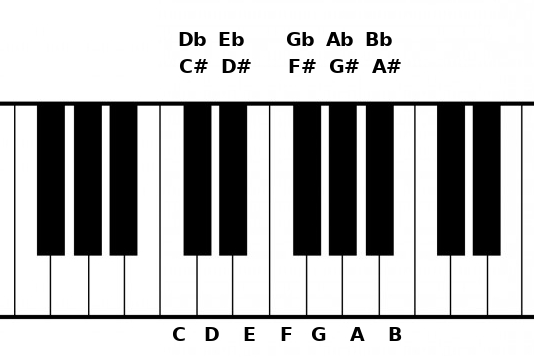Music theory in F# - Random note
This is the first part of the music theory in F# series:
- Introduction
- Step 1: Random note
- Step 2: The Major scale
- Step 3: Chords of the Major scale
Theory
There are 12 notes in occidental music theory, 7 natural and 5 altered:
Natural: C, D, E, F, G, A, B
Altered: C#, D#, F#, G#, A#
Each notes are separated by a semitone. If you look at a piano board, the white keys are the natural notes and the black keys the altered:

A sharp (#) means that the base note is a semitone higher, so A# is a semitone higher than A.
A flat (b) means that the base note is a semitone lower, so Bb is a semitone lower than B.
A# and Bb are enharmonic, it means that they produce the same sound.
If you add 12 semitones to a note, upwards or downwards, the note will be the same from the start but with a higher or lower pitch. They are called octaves.

Code
Like I said before, some notes produce the same sound, so for the sake of simplicity, I will represent only sharp notes and not flat ones for now.
type Note =
| C | CSharp
| D | DSharp
| E
| F | FSharp
| G | GSharp
| A | ASharp
| B
module Note =
let all = [
C; CSharp
D; DSharp
E
F; FSharp
G; GSharp
A; ASharp
B
]
The type Note is a union type which mean
It’s either
AorASharporBor …
The Note module lists all the functions and values related to the concept of Note. all is the list of all possible Note.
Now, I want to choose a random note:
open System
let random = Random()
let randomIndex = random.Next(0, Note.all.Length)
let randomNote = Note.all.[randomIndex]
randomNote is the note at a random index between 0 and 11 in the Note.all list. FSI shows the random note, but a fancier representation will be better:
module Note =
let name note =
match note with
| CSharp -> "C#"
| DSharp -> "D#"
| FSharp -> "F#"
| GSharp -> "G#"
| ASharp -> "A#"
| n -> string n
// other functions and values
// previous code with randomNote
printfn "Chosen note: %s" (Note.name randomNote)
match ... with is a pattern match, it’s like a (very) powerful switch. So name works like this:
- If it’s a sharp note, return
"...#" - Else return the string representation of the note
Another big F# feature is that the compiler infers a lot of things for you. It can infers that name is a function that takes a Note as argument and returns a string because the pattern matching matches Note values and returns string. So no need to be explicit about the types in general, the code will be more concise with this strong typing. But if you prefer to be explicit, you can rewrite this function as follows:
module Note =
let name (note: Note): string =
match note with
| CSharp -> "C#"
| DSharp -> "D#"
| FSharp -> "F#"
| GSharp -> "G#"
| ASharp -> "A#"
| n -> string n
Then the printfn function write in the console:
Chosen note: F#
You can also use the |> operator to simplify the code:
randomNote
|> Note.name
|> printfn "Chosen note: %s"
This operator is like the | operator in Unix, it takes the value on its left and passes it as the last argument of the function on its right:
let increment x = x + 1
increment 2 // returns 3
3 |> increment // returns 4
It is a powerful operator which is used a lot in F#.
Conclusion
That’s all for this step. You can check out the full code here.
Next step: The Major scale